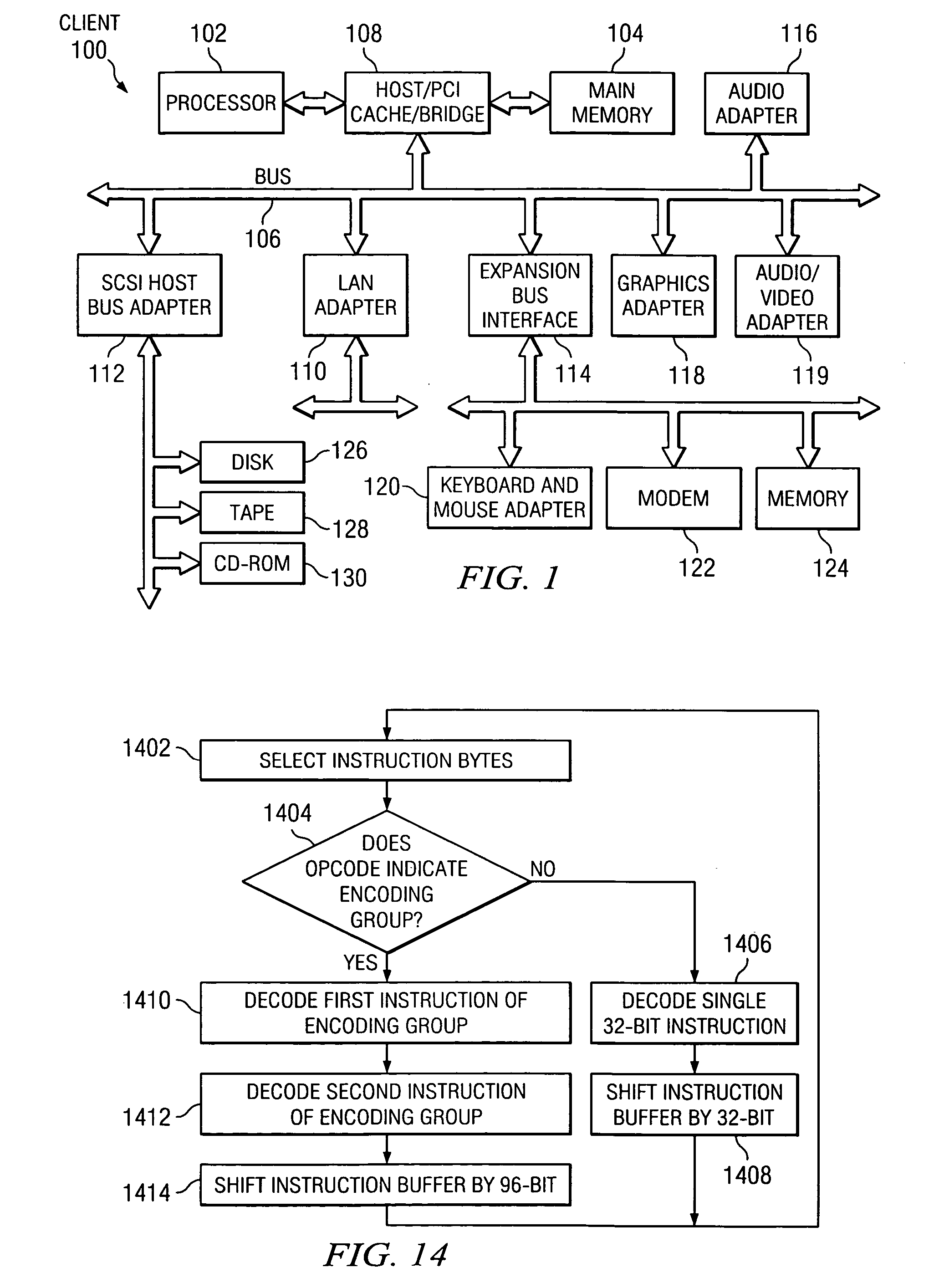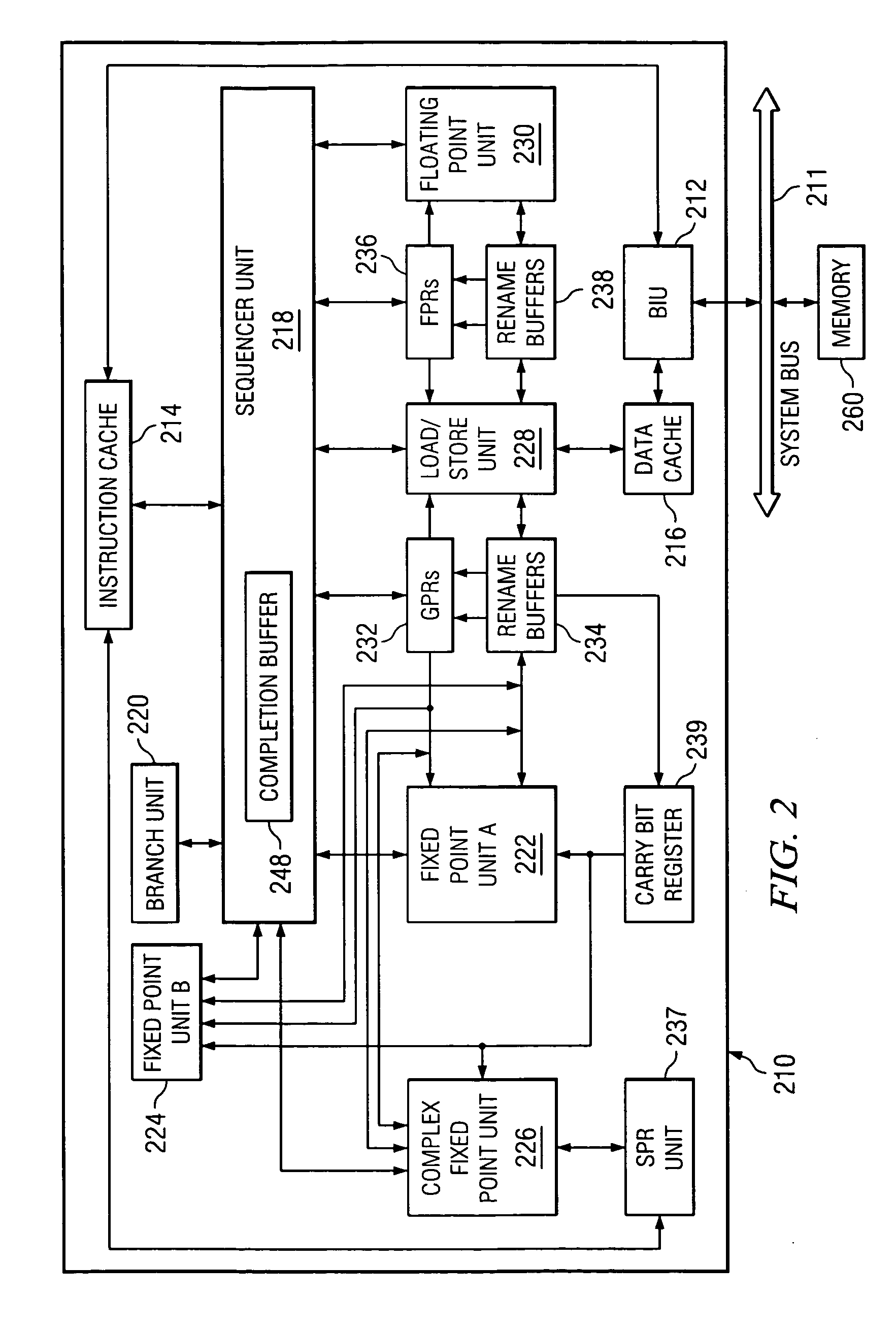Unfortunately, in most RISC architectures there is not sufficient space in a 32-bit instruction word for operands to specify more than 32 registers, i.e., 5-bits per
operand, with most operations requiring three operands and some requiring two or four operands.
However, with only a fixed number of bits in an instruction word, it has become increasingly difficult or impossible to add new instructions and specifically operation code encodings (opcodes) and wide register specifiers to many architectures.
However, traditional variable instruction lengths, e.g., as those employed by the Intel 8086 architecture, have at least three significant drawbacks.
A first drawback to the use of
variable length instructions is that they complicate the decoding of instructions, as the instruction length is generally not known until at least a part of the instruction has been read, and because the positions of all operands within an instruction are likewise not generally known until at least part of the instruction is read.
A second drawback to the use of
variable length instructions is that instructions of variable width are not compatible with the existing code for
fixed width data processor architectures.
A third drawback is that conventional
variable length instructions require complex decoders which can start at arbitrary instruction addresses, complicating and slowing down instruction decode logic.
Although the use of a
fixed width 64-bit instruction word (or other higher powers of two) may allow for avoiding the first and third problems mentioned above, the use of a fixed width 64-bit instruction word still does not overcome the second problem.
In addition, the use of 64-bit instructions introduces the further difficulty that the additional 32-bits beyond the current 32-bit instruction words are far more than what is needed to specify the numbers of additional registers required by deeper instruction pipelines, or the number of additional opcodes likely to be needed in the foreseeable future.
The use of excess instruction bits wastes space in main memory and in instruction caches, thereby slowing the performance of the data processor.
This method is undesirable as variable length instructions are inherently slow and hard to decode.
The teachings of this patent require base instructions to be aligned at instruction word boundaries, leading to restrictions in possible instructions to be used.
Such
signal crossing is costly in modern designs.
While this type of instruction encoding avoids problems with page and cache line crossing, this type of instruction encoding also exhibits several problems, both on its own, and as a technique for extending other fixed instruction width ISAs.
First, without incurring significant implementation difficulty (likely slowing the execution speed and requiring significantly more
integrated circuit die area), this instruction encoding technique permits branches to go only to instructions starting with an operation encoded as the first of the three operations in a 128 b instruction word, whereas most other architectures allow branches to any instruction.
Second, this technique also “wastes” bits for specifying the interaction between instructions.
Third, the three operation packing technique also forces additional complexity in the implementation in order to deal with three instructions at once.
As a result, there is no obvious mechanism to achieve compatibility with other fixed width instruction encodings, such as the conventional 32-bit RISC encodings.
The first drawback stems from the fact that all instructions must be extended, even when only a few instructions on a page require the extension, leading to possibly significant inefficiency of such a page.
The second drawback limits the free interlinking of binary object modules compiled with and without this extension, and specifically requires the link editor to either separate functions compiled employing the extensions from those not employing those extensions, or to patch the precompiled object modules not using the extensions to employ the extensions.
However, this architecture is optimized for such applications as
digital signal processing (DSP), and thus is limited to DSP and similar applications.
Specifically, indirect methods in instruction words suffer from the following drawbacks.
However, while each FLIX instruction can be independently encoded and scheduled, the VLIW format requires that slots be properly coordinated, and globally shared functions between several execution operation types not be encoded in a single FLIX instruction.
As all operations are executed in parallel, this would create a resource conflict, and hence it is illegal to bundle multiple operations that use the same globally shared functions.
Thus, because the FLIX instruction words encoded operations which must be executed in parallel, and not instructions which can be scheduled and executed independently from each other, this makes the encoding unsuitable for dynamically scheduled machines that require the instruction scheduler to resolve execution resource dependences, and serialize resource and
data dependent instructions.
The Tensilica
instruction set does not use fixed width instructions, yielding an
instruction stream consisting of 16-bit, 24-bit, 32-bit, and 64-bit variable length instructions with arbitrary 8-bit alignment for any instruction address, resulting in the same instruction alignment issues as traditional variable length (CISC) instruction sets.
This limitation makes this approach unsuitable for inclusion in a
fixed length RISC ISA.
 Login to View More
Login to View More  Login to View More
Login to View More 


